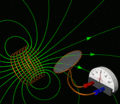Electromagnetic induction facts for kids
Electromagnetic induction is where a voltage or current is produced in a conductor by a changing magnetic flux. It may happen when a magnet is moved in a solenoid, thus changing the magnetic flux.
Magnetic flux
When a coiled wire is introduced near a magnet, the magnetic lines of force pass through the coil. This causes the magnetic flux to change. Magnetic flux is represented by the symbol  , therefore we can say that
, therefore we can say that  = BAcos(a) and the resulting unit will be
= BAcos(a) and the resulting unit will be  , where T is the unit for magnetic field and
, where T is the unit for magnetic field and  is the unit for area.
is the unit for area.
The changing magnetic flux generates an electromotive force (EMF). This force moves free electrons in a certain way, which constitute a current.
Faraday's law
Michael Faraday found that an electromotive force is generated when there is a change in magnetic flux in a conductor.
His laws state that:

where,
 is the electromotive force, measured in volts;
is the electromotive force, measured in volts;
 is the change in magnetic flux, measured in webers;
is the change in magnetic flux, measured in webers;
 is the change in time, measured in seconds.
is the change in time, measured in seconds.
In the case of a solenoid:

where,
N is the number of loops in the solenoid.
Lenz's law
The negative sign in both equation above is a result of Lenz's law, named after Heinrich Lenz. His law states that the electromotive force (EMF) produces a current that opposes the motion of the changing magnetic flux.
Related pages
Images for kids
-
Alternating electric current flows through the solenoid on the left, producing a changing magnetic field. This field causes, by electromagnetic induction, an electric current to flow in the wire loop on the right.
-
Faraday's experiment showing induction between coils of wire: The liquid battery (right) provides a current that flows through the small coil (A), creating a magnetic field. When the coils are stationary, no current is induced. But when the small coil is moved in or out of the large coil (B), the magnetic flux through the large coil changes, inducing a current which is detected by the galvanometer (G).
See also
 In Spanish: Inducción electromagnética para niños
In Spanish: Inducción electromagnética para niños





